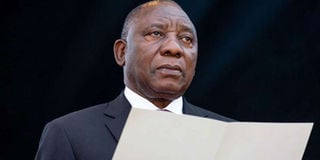South Africa’s economic tightrope tougher still as debt hits the roof

Cyril Ramaphosa takes the oath of office at his inauguration as South African President, at Loftus Versfeld stadium in Pretoria, on May 25, 2019. PHOTO | YESHIEL PANCHIA | POOL | AFP
What you need to know:
- Even with inflation at just over four per cent and with an offering of the country’s sovereign debt garnering $5 billion, the rest of the economic picture is bleak.
- There is also no obvious solution to the problem of Eskom, the behemoth of the economy, which is losing money due to poor management and outdated electricity-generating systems.
- With dwindling revenues, President Cyril Ramaphosa’s administration has almost nowhere left to go but take the austerity route.
The outlook is not good. That was the harsh assessment of South Africa’s Finance Minister Tito Mboweni on Wednesday.
This is not news to South Africans, who experience high prices, less money and joblessness daily.
Even with inflation at just over four per cent and with an offering of the country’s sovereign debt garnering $5 billion, the rest of the economic picture is bleak.
Revenue from tax is down by more than $3 billion and is projected to fall again in the next fiscal year. The national debt could reach $300 billion by 2023 on current trends – 70 per cent of the GDP.
ESKOM
There is also no obvious solution to the problem of Eskom, the behemoth of the economy, which is losing money due to poor management and outdated electricity-generating systems.
No plan seems to be on the horizon as far as Eskom goes, with unions against privatisation.
The vast utility – Africa’s largest, with 46,000MW of installed capacity but running only at about two-thirds efficiency – seems impossible to render profitable.
The government has set its sights on sorting out the monster that is eating up state funding at $1.5 every year.
Stabilising Eskom and its finances is critical for the recovery of South Africa’s economy.
PRAYER
Mboweni’s assessment of the utility and the economy were underscored by his call for a “prayer”.
The minister said his mid-term budget speech was not the time for poetry “but to speak about hard facts and figures”.
He admitted that one of the problems is the bloated public wage bill.
But union and communist allies of the ruling African National Congress were adamant before and after Mboweni delivered his address that they would never allow mass retrenchments – at Eskom, state-owned enterprises (SOEs) or government departments.
There are around 10.5 million South Africans out of work and the issue of putting government employees on the street will not be taken lightly.
AUSTERITY
The minister said many SOEs, including SA Airways, would never make a profit.
With dwindling revenues, President Cyril Ramaphosa’s administration has almost nowhere left to go but take the austerity route.
Yet that road is almost certain political disaster against the backdrop of an already restive population, many of whom are used to taking to the streets.
Mboweni addressed another anti-apartheid heritage – that of citizens not paying for government-supplied services.
Back in the apartheid era, that tactic – along with attacks on local government agencies, representatives and infrastructure – played a part in making the country ungovernable.
PAYMENTS
Mboweni and Ramaphosa have emphasised that everyone has to pay for services.
Eskom is owed a significant portion of its $33 billion debt by municipalities whose residents have not settled their power bills.
But turning off the power leads to outrage and yet another round of burning-tyre barricades, stoning vehicles and rioting.
With so-called service protests still on 20 months after Ramaphosa took office, simply calling on South Africans to pay their way is not going to change things – especially since many are unemployed and poverty-stricken.
The question that has lain before Ramaphosa and his team after the looting under his predecessor has been how to fix the mess without alienating the masses.
COUNTRY BROKE
A round of severe belt-tightening – the only realistic way to avoid the country falling off the fiscal ledge – is the last thing ANC wants just 18 months to local government polls, where it is at its weakest.
The government has been focused on increasing growth, upping tax revenues, cutting back state expenditure, stabilising and eventually reducing the deficit, reconfiguring SOEs and cutting the public wage bill.
Despite signs of improvement, the country is effectively broke. It is only the prospect of some future turnaround that is keeping foreign investors interested.
But such a turnaround depends on Ramaphosa, Mboweni and their colleagues convincing South Africans that cutting back public spending is the only answer to the woes and it must be done to save the country. It is a gamble for Ramaphosa, his supporters and the country.
As Mboweni muttered, things are not looking good.
Chris Erasmus writes from Cape Town, South Africa.





